July 17th was a beautiful day in the southern-most part of Walpack Township where Walpack Historical Society sponsored a presentation at the Lower Walpack Cemetery. Over 70 guests arrived in anticipation of hearing Sharon Spangenberg share her research on the history of this ancient cemetery. Shortly after 1:00 pm, our guests found a shady spot to set up their lawn chairs to listen to Sharon talk about the cemetery, the history of the property surrounding the cemetery, the military veterans buried there, as well as the maintenance that a small group of volunteers have done over the past three years. Sharon’s typed text of her presentation is being shared below for those who were unable to attend. At the conclusion of her presentation, guests were offered a tour of the cemetery, a stroll down the Rosenkrans Ferry Lane, a visit to the Dutch Reformed Church site, as well as light refreshments while they watched a power point slide program showing the work that was done in the cemetery and the repairs made to many gravestones.
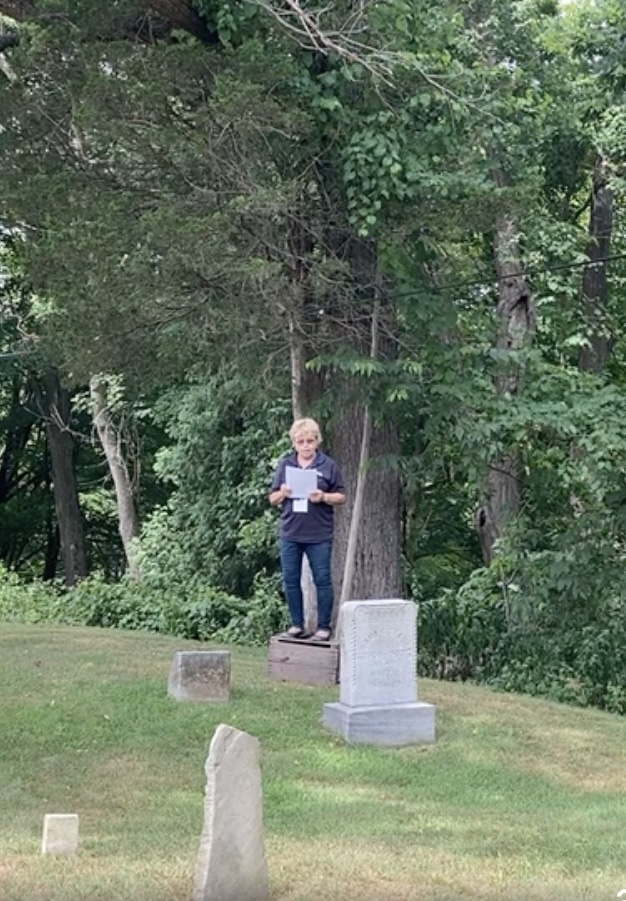
As Don said, I am Sharon Spangenberg. Welcome to the Lower Walpack Cemetery.
For those of you who arrived early, I hope you were able to enjoy one of the most beautiful, peaceful, and historic places in Sussex County.
Today I will be giving you a brief history of this ancient cemetery which is believed to be the second oldest in Sussex County, as well as what our maintenance team has accomplished the past three years, and to tell you a little about some of the families who settled here in what was once an untamed wilderness.
In 1727, Nicholas Schoonhoven and his brother-in-law, Thomas Brink purchased 500 acres of land here in Walpack. According to a West Jersey Deed, this land was identified as being about three (3) miles above Pahaquilong and fronts upon the river Delaware. Pahaquilong is an Indian word meaning “the place between the mountains beside the waters.” This means you are now standing on land that those two men purchased from Proprietor, Joseph Kirkbride nearly 300 years ago when it was a British colony.
Ten (10) years later on February 1, 1737, Schoonhoven and Brink granted about four acres of land to the inhabitants of Walpack. That property, “beginning at the northwest corner of the burying yard,” suggests that this burial yard was established prior to 1737.
An association was first formed 140 years later under the name of The Walpack Cemetery Association. All eight (8) of the trustees are buried in this cemetery.
Thirty-eight years after that in 1915, the corporate name changed to “The Lower Walpack Cemetery Association.” Only three (3) of the seven (7) trustees are buried here.
Forty-eight (48) years ago in preparation for the Tocks Island Dam Project, the Army Corp of Engineers hired a company to visit all cemeteries that would have potentially been in danger of being flooded. They documented all gravestones in anticipation of moving them to a selected site in Sandyston Township. We found many more gravestones than what had been documented.
As the years passed, members of the Rosenkrans family maintained the cemetery and continued to do so until the last descendant who owned the house you can see to the west, sold the property to the Federal Government in June 2017. It was then that this cemetery became abandoned. Concerned for its neglect, in November of the following year, several of us struggled to mow this very overgrown cemetery.
Although I am the one who welcomed you here today, Dan Tassey, my husband Hixon and I make up our dedicated core team of three who have been mowing and maintaining this cemetery since the spring of 2019. Although Jeff Stoveken now helps when he can, for the first 2½ years he was an active and dedicated volunteer who mowed, cut brush, and re-erected gravestones each week along-side the three of us. Several others have also been helpful over the past three years. They include, Matt Hoskins, Mark Miller, Eugene Rosenkrans, Audrey and Bill Schwab, Bob Williams, and my granddaughter, Madison. We even had help from Nathan and John Schoonover who came here from Bradford County, PA. This year, we welcomed a new volunteer. Andy Chernati showed up for our first mowing with his zero-turn mower and has continued to help mow each week since. What used to take at least 12-man hours to push mow the cemetery, now takes us less than half the time. We are so fortunate to have Andy join our team.
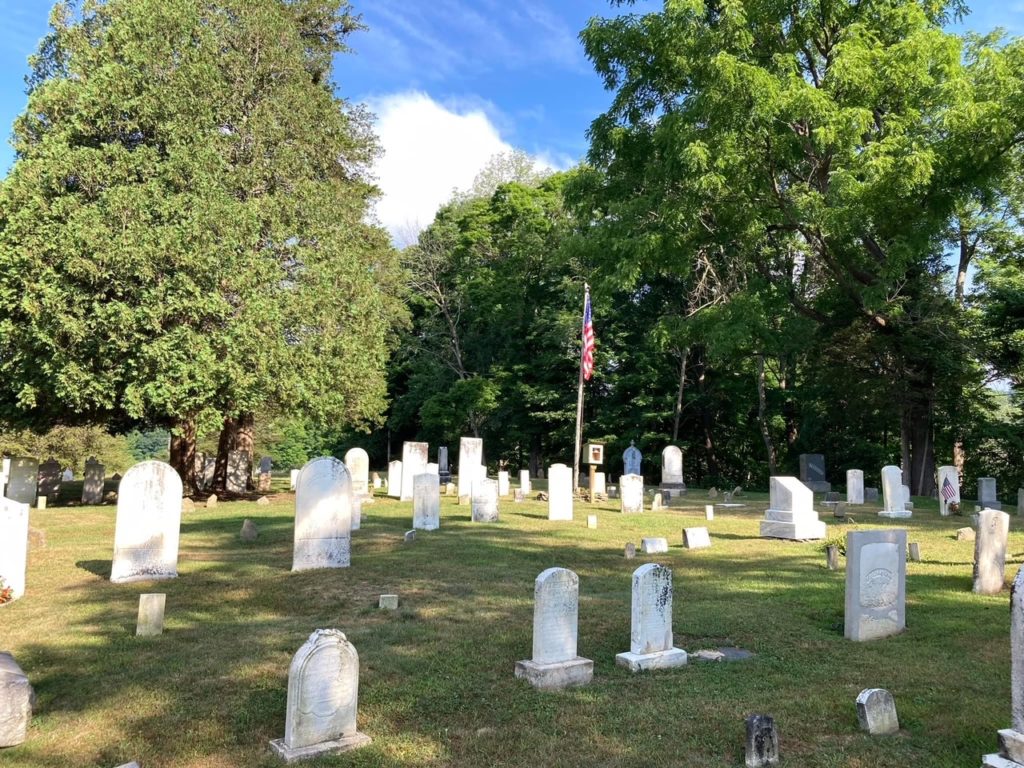
Over the past three years, from mid-spring to late fall, our dedicated team spent every Friday and most Sundays here at the cemetery to make it look the way it does today. Although more work needs to be done, so far, we
- Reclaimed the north edge of the cemetery as well as the open field
- Purchased and installed the welcome sign you may have seen while driving in
- Erected a cedar flagpole with a 4’ x 6’ American flag and solar light, and added a small flower garden at its base
- Purchased flag holders for all military veterans who did not have one
- Installed a small information house next to the flagpole and
- Cleaned almost all the gravestones so that they are now quite legible
Besides that, we probed and discovered many grave markers including:
- 22 headstones found underground were re-erected
- 39 headstones leaning or laying on the ground were re-erected
- 5 very large gravestones were hoisted back on their base
- 2 badly broken and fragile gravestones were repaired and are now re-erected, and
- 15 other gravestones were repaired
In addition:
39 footstones were found underground and are now re-erected.
There are thirteen men buried here who served our country in the Military, three are veterans of the Revolutionary War, they are: William Hill, Jonas Smith, and Nathaniel VanAuken. Five served in the War of 1812, and they are: Andrew D. Decker, William Dunn, Andrew Hill, Benjamin Hull, and Jacob Smith; as well as five soldiers of the Civil War who are Simeon Earl, George A. Garis, Alexander Hornbeck, George LaBar, and Henry D. Snover. As you look around the cemetery, you will see that all are honorably recognized with an American flag in an appropriate flag holder with the veteran’s name etched on the back. Each one also has a small flower planted in front of their gravestone. One other American flag is placed at the gravesite of Asa Losey who was employed by the United States Customs during World War l.
There are currently 345 documented burials; 267 have an inscription, 67 are marked by only a fieldstone, and 11 are possible grave sites identified by a depression in the ground. Nearly 1/3 of the gravestones also have a footstone.
The oldest gravestone that we have found thus far has a date of 1752. The only letters on that stone, we believe, are IDM or any combination of those intersecting letters. Although you may have seen on the find-a-grave website that a person by the name of Eliza Jyil who died on August 11, 1737 is buried here, that burial cannot be confirmed as her gravestone has not been found. In fact, this name does not appear in any online records.
The last burial here was Dolores Rosenkrans who died in 2008. Mrs. Rosenkrans was the last Clerk of this cemetery, and her remains are buried next to her husband Benjamin who died in 1984. Benjamin and Dolores once lived in the house at the end of this lane as well as the only home still standing in Flatbrookville. Their son Eugene is here today and I am sure he would welcome any question you may have about his family’s homestead.
As you walk through the cemetery, you will see the gravestones of Moses Hull and his family. Some of you may wonder why Moses and his son Victor have gravestones here as well as along Military Trail behind the Van Campen Inn. It has been told that those two gravestones on Military Trail were found many years ago in a field close to the Delaware River. At that time, it was felt that because a family monument with inscriptions of six family members was erected in the Hull family burial plot, that those two gravestones should be placed along the road on the property that was once owned by Moses Hull. Those two gravestones that have been on Military Trail for nearly 50 years are referred to as Cenotaphs. The dictionary definition of cenotaph is “an empty tomb or a monument erected in honor of a person or group of people whose remains are elsewhere.”
This cemetery is the final resting place of many frontiersmen and women who settled here nearly 300 years ago. They helped tame the wilderness, fought to protect their families from attacks during the French and Indian and Revolutionary Wars, and created American qualities of independence, self-reliance, and bravery. To remember them in their resting place shows respect for the hardships they experienced and what they accomplished with their hard work for future generations.
Several years before our team began caring for this cemetery, a Walpack Historical Society Trustee and I were given permission to look for hidden gravestones. It was on that day that a headstone and footstone were found side-by-side about 6 inches underground just off the north edge of the cemetery. That headstone is quite unique as it is 36” long and only 6” wide. The footstone is similar but somewhat smaller. The inscription reads, Henry Schoon Hoven died August 16, 1771, aged 72. That meant he was born in 1699. Research revealed that following the death of his father sometime after 1715, Henry and at least three of his siblings moved to this area from Esopus (now Kingston), New York and settled in Walpack. Henry’s name is mentioned many times throughout the Dansbury Diaries book of the Moravian Travels from 1748 through 1755. He and his siblings were visited frequently by the Moravian Missionaries, and they eventually became part of the Moravian congregation. Henry’s name also appears in a 1763 road return as owning property less than one mile north of here. Henry was also identified in a 1759 document recommending he continue to be a tavern keeper in Walpack. Further research revealed, much to my surprise, that Henry Schoonhoven was my husband’s 7th great-grandfather. It was at that moment, I knew I had to return to see if there were other ancestors of my husband buried here, and there are many.
Late in the evening of July 4th, 2020, while walking through the cemetery with a probe, a stone was found underground. When it was removed, we were able to read the inscription “here lies the body of NSH who died on June 10, 1764.” The following day, research revealed that not only was there never a record of this gravestone, but it was in fact that of Nicholas Schoonhoven born in 1694. How exciting it was to have found the gravestone of one of the two men who granted the land where this cemetery is located. Even though we have not found Thomas Brink’s gravestone, we are continuing to probe in the hopes it will be discovered. By the way, Nicholas and Henry Schoonhoven are brothers.
For 26 years Brink and Schoonhoven jointly owned the property surrounding this cemetery. Then in 1751 they divided their shared land. Brink retained the property here until his heirs conveyed the property to Captain Manuel Hover and his wife Mary Schoonhoven, daughter of Nicholas Schoonhoven.
One of the three Revolutionary War veterans who is buried here is Jonas Smith. Jonas was a member of the Northampton County Pennsylvania Militia in the Revolutionary War having taken his father’s place. He and his wife, Anna Maria Labar, also known as Mary had 11 children in 18 years. In 1797, he purchased 175 acres in Walpack from Captain Manuel Hover with the exception of a ½ acre for this burial ground. According to Albert Fiacre, author of the Smith families of Northampton County, Pennsylvania as well as Sandyston and Walpack Townships. Jonas was an Elder of the Walpack Dutch Reformed Church and was one of only three Germans who were members of that church. He then helped facilitate the establishment of the Union Congregation of the German Reformed Church in 1820 which was located at the top of this lane, and he built the timber frame house that you see at the end of this lane. Of their 11 children, few remained in the area and only two are buried in this cemetery. After Jonas’ death, his son, Philip J. Smith acquired the homestead. Philip died on October 6, 1848, and his wife Elizabeth died four days later. After their deaths, the homestead was taken over by their eldest daughter Mary who was married to Benjamin Rosenkrans. Today, the house you see is known as the Rosenkrans house. When you look over the gravestones of Jonas and Mary Smith, their former homestead is in clear view.
Another man who was important in the development of the Minisink Valley was Nathaniel VanAuken. Nathaniel was born in what is now known as Port Jervis, New York. According to his Pension application, he entered the Revolutionary War as a substitute for family members. After serving in the Revolutionary War, he moved to Walpack where he purchased several tracts of land. At the time of his death he owned 177 acres just 2½ miles east of here. That property was located near the hairpin turn where those who are familiar with this area, know it as the Treible or Handler Property.
Our third Revolutionary War soldier buried here is William Hill. William and his wife Abagail Knapp were parents of 12 children. Only one son, Andrew and his wife Elizabeth Gariss are buried here as well as a few of their descendants. I will now turn the program over to my husband Hixonwho will tell you about William.
(Transcribed from the video tape)
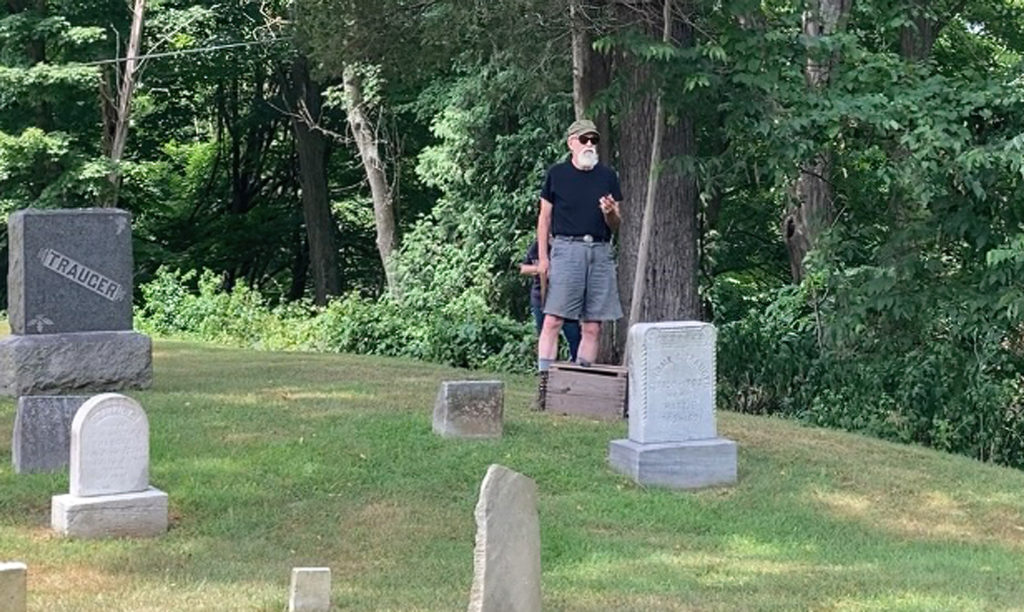
Hello everyone. I’m Hixon Spangenberg. I am a direct descendant of William Hill. There are several others here today who are also descendants of William Hill. William’s grandfather came to this country in the year 1720. He was in New York City and moved up to Dutches County in the Kingston area and his son, Andrew was active in the Revolultion and became a Major of the Militia in the 2nd Regiment up in Dutches County. His son William who is buried here was a young man of 13 years of age. It is said that he was large for his age when he volunteered to join the militia. He volunteered and served for four years in various positions. It was a couple of years before he could become a legal member of the militia. He eventually was a private and then became a corporal. He helped guard the passages up in the mountains in the Hudson Valley region from the incursions of British Officer and Mohawk Chief Joseph Brant and his Indians. He also accompanied 300+ wives of the Scotts and their families up to the Great Lakes so they could go into Canada. And the British met them and took the children of the Scotish soldiers into Canada. He also helped build a fort on Constitution Island which is on the Hudson River near West Point. After the war he and his wife Abigail Knapp, in 1790 decided to come down the Delaware River to the Walpack area. He had two children at the time. Some say he came in a canoe, others say he came on a raft. He spent the night on Fiddlers Elbow where one of the Decker families welcomed them and offered them to spend the night. For their hospitality, he gave them a butterbowl which has been held in high regard by the Decker family ever since that time. He purchased 500 acres above Flatbrookville, that’s north of Millbrook. Up there he erected a saw mill, cleared the land, and built a tremendous amount of stone walls. He and his sons and daughters lived in that area for a long time. One of his sons also had a saw mill, a tanning mill, and a currying lot. He had several children that remained in the area and the land was divided among his offspring. William and Abigail are buried here and I would be happy to show you their final resting place. Thank you.
I want to summarize how the property surrounding this cemetery ended up the possession of the Rosenkrans family:
From 1725 until 1797, the Schoonhoven/Brink/Hover families owned the property for 72 years.
The Smith family owned and lived here from 1797 until 1858 when Mary Smith and her husband Benjamin Rosenkrans acquired the property – that’s 61 years.
From 1858 until 2017 the property was the Rosenkrans family homestead – that is 159 years!
There are many other stories that could be told about those buried here, but that will need to wait for another time as I will now turn the program over to Dan Tassey who will tell you about the small tree that was recently planted in this field.
(Transcribed from the video tape)
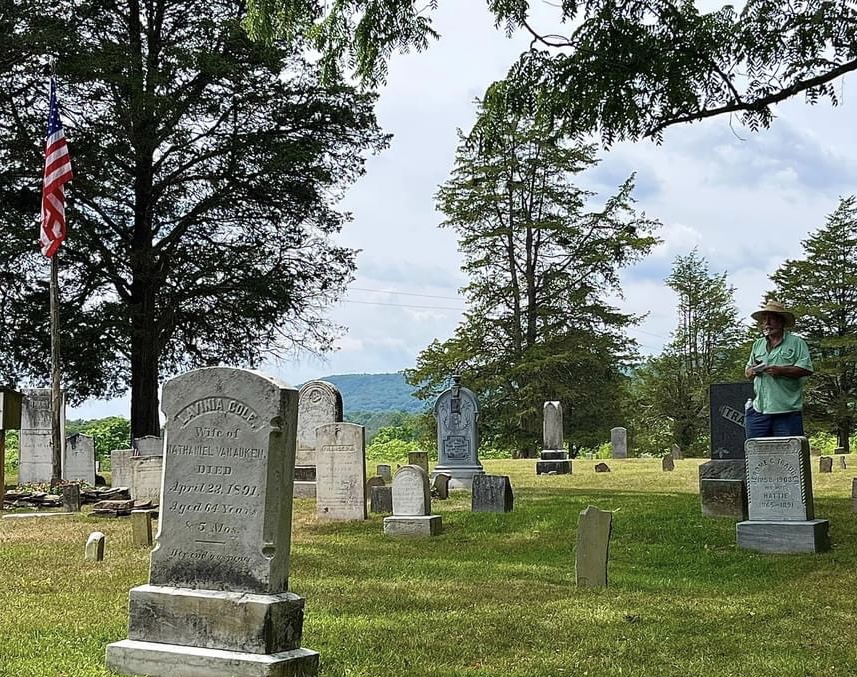
Good afternoon. When you pulled in you may have noticed that there is a small cage down there with a little tree planted inside it. This is a pretty special tree as it is an offspring of the Salem Oak tree in Salem NJ. The Salem tree is where the Lenape Indians and John Fenwick of West Jersey signed a treaty, which is quite unique. (Madison, could I have you come up here for a minute please.) We obtained this tree from the State of New Jersey. One of the State foresters had a brainstorm to pick up the acorns while he was inspecting the tree. He figured he would propagate this tree somehow. Within a year, the tree, out of the clear blue sky, tumbled over for no reason. They figured it was over 600 years old and was located in the Quaker Burial Ground. So it is pretty special to have one of these trees here in Walpack. Small seedlings were offered to all municipalities in the State of NJ, but only forty of them were given out that we know of, and there have been only three that were actually planted, that we know of. One of the things that makes it very special are the people who planted the tree. We had a reenactor who has done William Penn for many years and has traveled all over the world. His name is Erik Burro; you may have heard of him. For this particular event though, he came as John Fenwick dressed in what would have been the garb of the day, I think it was in 1674 when he and the Lenape Indians signed their treaty. Not only did John Fenwick show up as our reenactor, but we also had the Lenape Chief, Vincent Mann of the Ramapo Indians and Mikey, the clan mother. It was a very special day as none of us had ever met them before. The whole treaty from 1674 was carried on to this tree here. What is unique about that is that Madison, John Fenwick and our local Indian chief all planted that tree together on that day. So a continuation of that treaty from Salem comes with the tree which is also recognized by the State of New Jersey now. That is kind of cool. All the history that was made in Salem underneath that tree, and everything that went on there, now comes here to Walpack. On the day that we planted that tree, the Chief spoke of a new tree as an environmental treaty recognizing all the things that have gone wrong on planet earth and how we have really destroyed the planet. To pass that on, he has actually put a new treaty in place with Madison who is the new keeper of the tree. She keeps a journal, she keeps the tree watered, and it is pretty exciting to have Madison here accepting that responsibility in taking care of the tree. We are not going to be here forever, so Madison will be the one to carry on our history here. By the way, many of her relatives and ancestors are buried here, so she has a real vested interest in taking care of the cemetery and the tree over the years when we are gone. I don’t know where she will get recruits to help her, but I’m sure she will find them. Madison and I will be over by the tree a little later on. If anyone wants to come over to chat, we can tell you more about that. I believe Sharon has more to say.
There are several things that you may like to know.
The Walpack Historical Society’s Fall 2020 and Winter 2021 newsletters had articles about Manuel Hover and his connection to the property surrounding this cemetery. If you are interested in reading about Captain Hover, there are a few copies of these articles on the table under the trees.
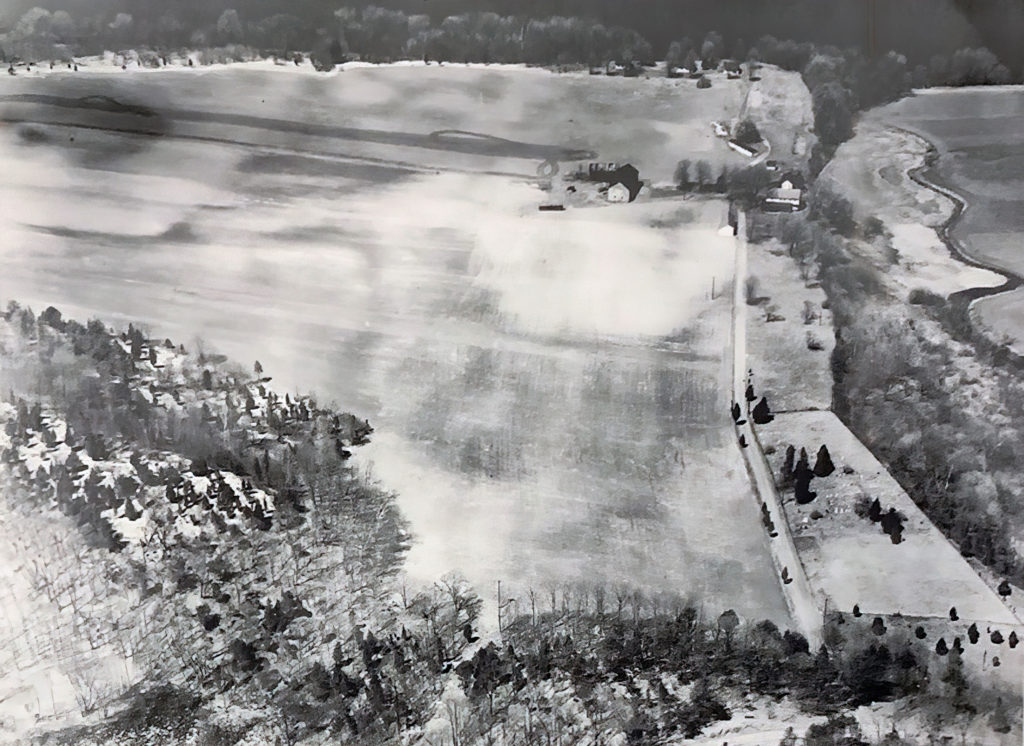
Our Winter 2022 Newsletter was dedicated to the October 23, 2021 Salem Oak Tree Seedling event that took place here. If you would like to read about the Salem Oak and that day’s event written by Erik Burro, that is available on the Walpack Historical Society’s website.
On the table under the trees, you’ll find some information about this cemetery including
- a map showing the location of all the gravestones
- the names and military service of all veterans
- the symbols and designs you will see on some of the gravestones and what they represent,
- the zinc grave marker
- and statistical information showing all family names
A detailed map with a listing of all burials plus a spreadsheet with additional information is available for sale on the table.
Earlier I referred to Albert Fiacre and his book on the Smith family. This 494-page hard cover book that took Al 16 years of research to complete, is a wonderful resource. In fact, it was recognized by the National Genealogical Society. Mr. Fiacre’s book is not just about the Smith family; the book’s index has over 500 family names mentioned who had a connection to the Smith family, including some well-known names from Walpack such as Decker, Gariss, McKeeby, Rosenkrans, and Transue.
The following is from Mr. Fiacre about his award.
“The National Genealogical Society holds a convention every year and sponsors various competitions and awards. I submitted my book in December 2017 to their competition for Best Genealogy and Family History. The book was selected as the best one submitted; so at their annual convention in 2018, I was recognized as the winner and was presented a certificate. In essence, the stamp of approval by the genealogical community was placed on the book as a quality product, valid as a source for others, as well as being the best one done in 2017.”
We have several copies of Mr. Fiacre’s book here today. If you are interested in purchasing this wonderful resource book, they are also on the table. I’m sure Mr. Fiacre would be happy to autograph your copy as he is here today.
As I said in the beginning, the Lower Walpack Cemetery is being maintained by volunteers. Although all of us are members of the Walpack Historical Society, we are a separate entity. During the first two years, three of us personally paid for the Welcome Sign, the large American Flag, the flag holders, the products and tools used to clean and repair the gravestones, as well as the gas, oil and air cleaners for the mowers and weed whackers. Through donations, we are now able to offset these continued expenses. If you care to help us out, there is a donation box on the table.
Also, Hixon, Dan, Jeff, or I will be happy to take you on a tour of the cemetery. As you walk through the cemetery, please be mindful of small holes and soft ground made by turtles laying their eggs and moles who have taken up residence.
One last thing, for those interested, we are offering you a chance for you to receive a free copy of the map of this cemetery showing names and dates of death for all burials. Here is your challenge: There are 13 gravestones that have the stone carver’s name etched somewhere on the headstone. What you need to do is find as many names as you can. When you locate one, write down the name of the deceased appearing on the gravestone. The person who correctly finds the most will be the winner of the challenge. Please see Madison who will give you a copy of how the Carvers’ names appear on the gravestone.
Feel free to walk to the Delaware River to the location of the Rosenkrans Ferry or to the site of the Dutch Reformed Church at the entrance of the lane. Both areas have been mowed to allow you easy access. Also on the table, are a few photos of the Rosenkrans Ferry while it was in operation.
Please enjoy some iced tea and donuts as you watch a slide show of the work that was done here and how the gravestones were repaired.
Are there any questions? Thank you so much for coming.

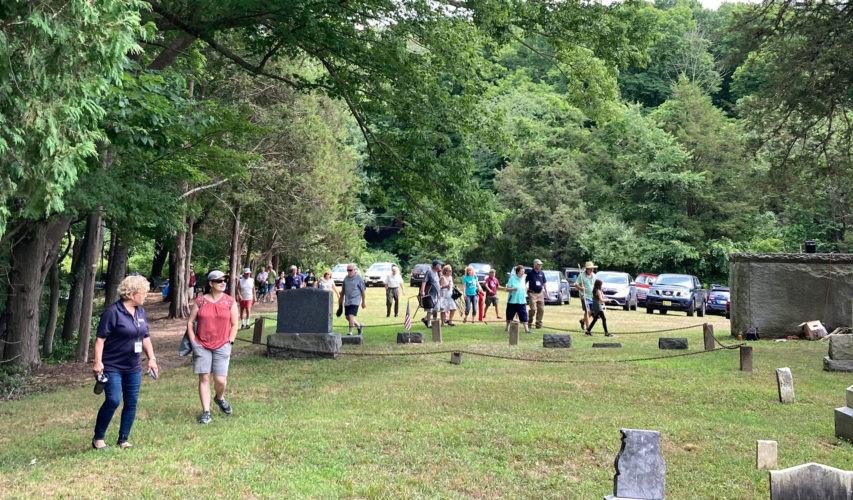
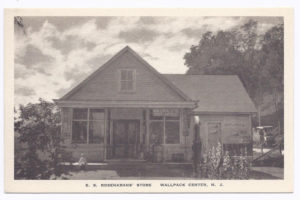
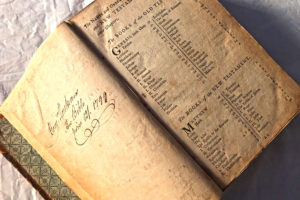
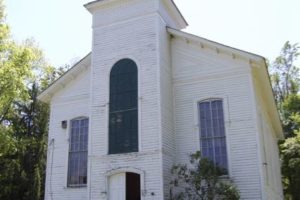
Permalink
I visited the area many years ago. Is the Lower Walpack Cemetery referred to in the presentation is the same where Ira Fuller is buried? 1849. I met with a lady who was the sister of “Red”Fuller. I believe she was married to a Rosenkrans. We had a nice visit rocking on her porch. At this time, she mentioned the Rosenkranz Cemetery. And started to walk up to it, but it was rather isolated. So after all this background, is this the cemetery referred to as Lower Walpack Cemetery? And is this Flatbrookville?
Permalink
Denise. Yes the Lower Walpack Cemetery IS the graveyard you and Delores Rosenkrans would have visited. It is located nine tenths of a mile from where you would have been rocking on the porch.
Ira Fuller is not buried in the Lower Walpack Cemetery. From the find-a-grave website, he is buried in the Walpack Center Cemetery located on Mountain Road, east of Walpack Center Village. Sharon